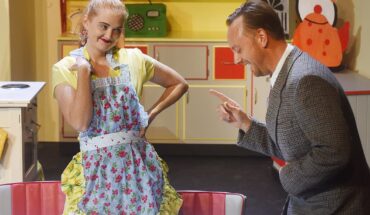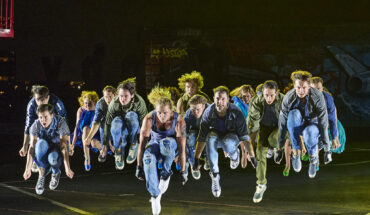See the best of contemporary art at the Biennale of Sydney with our Plus Ones’ Guide.

Semiconductor, Earthworks, 2016
There are 70 artists from 35 countries, exhibited across 7 venues. All artworks, except for two, are free to see. In lieu of a print catalog, the Biennale is providing online overviews of artists and venues.
Sydney’s Biennale was first launched in 1973 to coincide with the opening of the Sydney Opera House. As the opera house signaled a debut on the world architecture stage, the Biennale was to do the same for Australia on the contemporary art stage. From the outset, organisers drew upon the country’s social and geographical reach, to showcase contemporary art from Australia and the Asia-Pacific region.
This year’s survey is global, and these are nine standouts.
Sound art at various venues
The trending contemporary art form is sound. When added to art and design, sound invites interaction. It is also crossing over from disciplines like engineering, science, and globalisation. Despite fragmentation of tradition, the best sound art makes the inscrutable accessible:
Semiconductor, Carriageworks
Science communication as landscape. Earthworks is a 5-channel analogue model that animates seismic waves of glacial, earthquake, volcano, and man-made activity. It is psychedelia with an electronic music soundtrack, the sonic pulsating with the tectonic. No wonder that NASA, too, syncs electronic sound with astrological, biological, and geological simulations. If ever an installation could anthropomorphize the ground beneath our feet, it is this.
Jacob Kirkegaard, MCA
Segregation as installation. Through the Wall replicates sounds of the Israeli West Bank Barrier. Background noise on either side are summed up as a soothing hum of pedestrian conversation, passing bells and whistles, detritus of daily activity. Kirkegaard uses sound ephemera as a neutral way to experience everyday life in contested places. Previous projects include Greenland, Chernobyl and Fukushima, places which are shorthand for environmental crisis.

Jacob Kirkegaard, Through the Wall, 2013
Oliver Beer, Sydney Opera House
Building as chorus. The interior space of buildings have an intrinsic or natural sound, according to Oliver Beer. For his Sydney Opera House commission, he presents a voice composition performed by classically trained singers in resonance with the space. Beer’s scores are site-specific, intended to show the acoustic identity of buildings. He uses choral voice to represent architecture as sound art, making visceral experiences that cannot be reproduced through media. Read more.

Oliver Beer, Composition for Tuning an Architectural Space, 2012/2018
Early contemporary at the Art Gallery of New South Wales
If you ever wonder “what is contemporary art?” or even, “how is that art?!” a visit to the state gallery is a good place to start. Before recent-contemporary began, there was abstract art, process art, outsider art, word-and-images art, land art, and participatory art. Examples:
Sydney Ball, AGNSW

Sydney Ball, Black reveal, 1968–69
Luciano Fabro, AGNSW
Architecture as process art, or architecture as semiotics. Screen-printed line drawings of the Roman Catholic church SS Redentore (Milan) appear to be an interpretation of architectural draftsmanship. It is however 1972 process art, where a conceptual or labour process is more important than the art object itself. Luciano Fabro used elements of architecture to represent a philosophical text by Dante Alighieri.

Luciano Fabro, Every Order is Contemporaneous of Every Other Order: Four Ways of Examining the Façade of the SS. Redentore in Venice, 1972
Marlene Gilson, AGNSW
Dispassion in history painting. Flat landscape perspectives of multi-figure scenes are associated with the Dutch and Flemish schools of painting. Extrapolating from this tradition, Marlene Gilson creates dispassionate distance with events that are otherwise pained in meaning. The viewer is at a remove, watching as Aboriginal people are displaced geographically and socially from scenes of colonial settlement.

Marlene Gilson, Melbourne Cup, 2016
Recent contemporary at Carriageworks and Artspace
Good contemporary art is measured not only by intent but also by affect. Narration or tradition matters. Each of these artists have an unconventional aesthetic that is honed through knowledge of conventions that preceded them:
George Ward Tjungurrayi, Carriageworks
Aboriginal colour field. Midway in his painting career, Tjungurrayi developed a signature linework that links Aboriginal tradition with contemporary Western abstraction. His geometric aesthetic is reminiscent of topographical landscapes and optical illusion. Tjungurrayi’s personal expression of songlines is similar to Abstract Expressionism and Minimalism, a coincidence that significantly differentiates his work from fellow Desert artists. His heritage gives his paintings a narrative that is simultaneously ancient and prescient, historical and timeless.

George Tjungurrayi, Untitled, 2008
Tanya Goel, Artspace
Mapping as process art. The city grid is a celebrated tool of modern urban planning, a means of implementing Cartesian order. It is at odds with the informality of cities in developing economies like India, where Tanya Goel is based. Her artwork is visually minimalist, akin to the modernist textures of Warren Rohrer and Agnes Martin. By sourcing pigments and material from New Delhi sites, she is quietly and meticulously mapping the erosion of history under the imposition of linearity.

Tanya Goel, Index, 2015
Michaël Borremans, Artspace
Dispassion in figurative painting. There is an eerie, unearthly familiarity in the paintings of Michaël Borremans. The Ghent-based Belgian is a rare specimen, a contemporary figurative painter long-committed to Velasquez the Old Master, Goya the Romantic, and Manet the Post-Impressionist. Borremans evokes nostalgia with his brushwork and deliberately informs his paintings with art history. His subjects look away, unsmiling and guarded, posed as though inwardly distracted. Unnervingly arresting in mood, Borremans captures the uncanny.

Michaël Borremans, The Bread, 2012
Contemporary art practice and platforms are transforming the art industry. To remain relevant as fairs and shows proliferate, biennale organisers are highlighting art history as a point of scholarly difference. The Biennale of Sydney Archive is an ongoing project to follow, through websites of the Biennale and the Art Gallery of New South Wales.
– Maloti
Maloti writes about art and music.
Biennale of Sydney runs until June 11.



